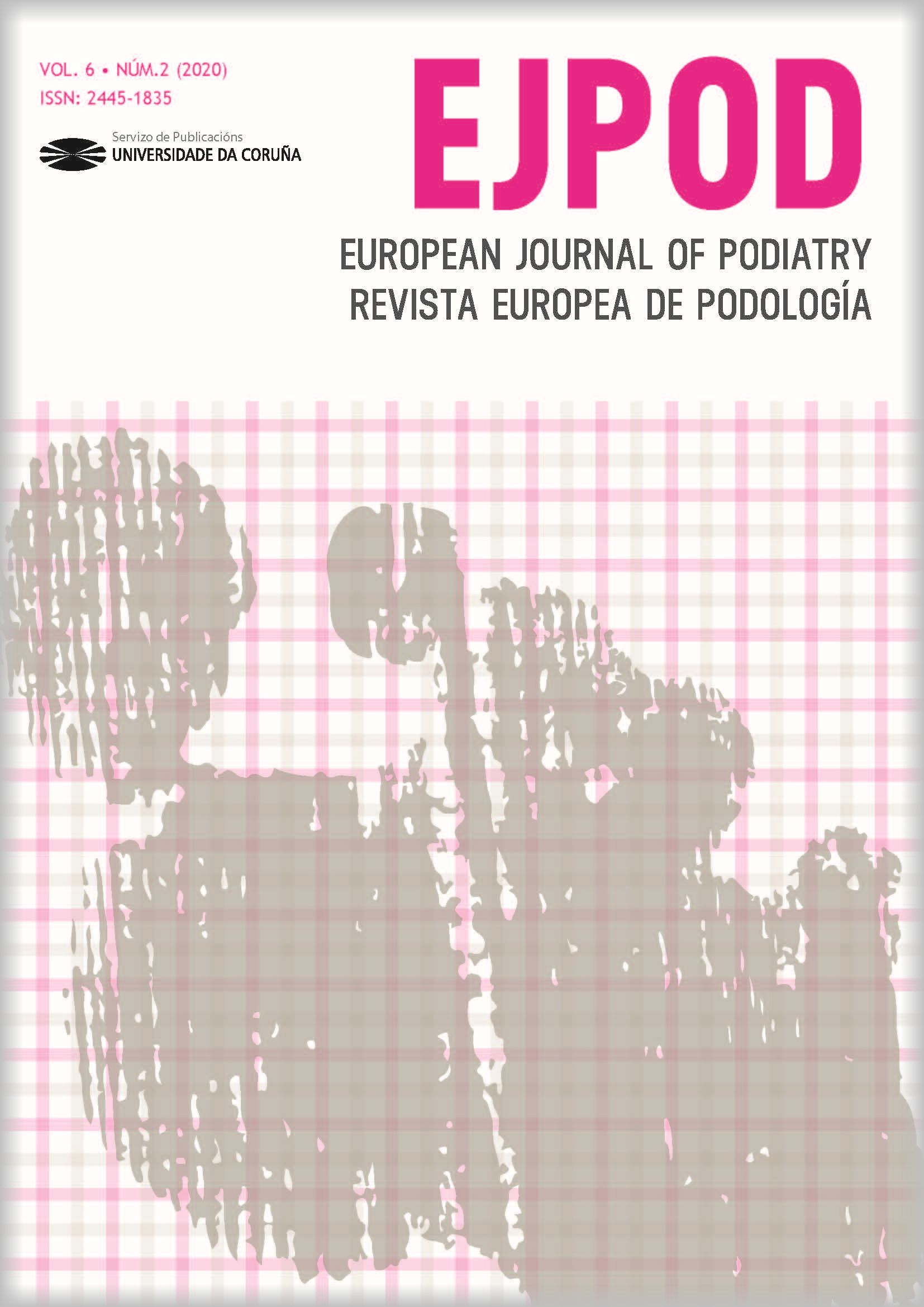Angiomiolipoma cutáneo en el pie: Caso clínico
Contenido principal del artículo
DOI:
https://doi.org/10.17979/ejpod.2020.6.2.6355Resumen
El angiomiolipoma cútaneo es la variante de partes blandas de los PEComas o tumores derivados de células epiteliodes perivasculares.
Compuesto por múltiples variantes, la más conocida el angiomiolipoma renal (AML), comparten un mismo patrón histológico. Pueden presentarse en múltiples localizaciones como el tracto gastrointestinal, genitourinario o en los tejidos blandos.
Son neoplasias histológicamente caracterizadas por abundantes vasos de pared fina acompañados de células perivasculares redondeadas y con citoplasma claro.
A nivel inmunohistoquímico, coexpresan marcadores melanogénicos (HMB45, Melan-A o tirosina) junto con marcadores musculares (SMA, actina, miosina, calponina y h-caldesmon).. Sin embargo, su positividad errática y no patognomónica unida a la baja prevalencia, dificulta la identificación y la consideración dentro del diagnóstico diferencial.
En este artículo se presenta un caso de angiomiolipoma cutáneo a nivel del pie derecho junto con un repaso breve de este tipo de tumores.
Palabras clave:
Detalles del artículo
Referencias
Folpe AL, Kwiatkowski DJ. Perivascular epithelioid cell neoplasms: pathology and pathogenesis. Hum Pathol. 2010;4(1):1–15.
Shin JU, Lee KY, Roh MR. A case of a cutaneous angiomyolipoma. Ann Dermatol. 2009;21(2):217–20.
Fletcher CDM, Unni KK, Mertens F. Pathology and Genetics of Tumours of Soft Tissue and Bone. WHO Classification of Tumours. IARCPress Lyon. 2002. 127–138 p.
Machado I, Marhuenda A, Trallero M, Caballero M, Santos J, Cruz J, et al. Hepatic epithelioid angiomyolipoma/PEComa and focal nodular hyperplasia in a patient with a previous history of cutaneous melanoma. Rev Esp Patol [Internet]. 2019;52(4):250–5. Available from: https://doi.org/10.1016/j.patol.2018.05.001
Bonetti F, Martignoni G, Colato C, Manfrin E, Gambacorta M, Faleri M, et al. Abdominopelvic sarcoma of perivascular epithelioid cells. Report of four cases in young women, one with tuberous sclerosis. Mod Pathol. 2001;14(6):563–8.
Folpe AL, Mentzel T, Lehr HA, Fisher C, Balzer BL, Weiss SW. Perivascular epithelioid cell neoplasms of soft tissue and gynecologic origin: A clinicopathologic study of 26 cases and review of the literature. Am J Surg Pathol. 2005;29(12):1558–75.
Xu H, Wang H, Zhang X, Li G. Hepatic epithelioid angiomyolipoma: A clinicopathologic analysis of 25 cases. Chinese J Pathol. 2014;43(10):685–9.
Thway K, Fisher C. PEComa: Morphology and genetics of a complex tumor family. Ann Diagn Pathol. 2015;19(5):359–68.
Gana S, Morbini P, Giourgos G, Matti E, Chu F, Danesino C, et al. Early onset of a nasal perivascular epithelioid cell neoplasm not related to tuberous sclerosis complex. Acta Otorhinolaryngol Ital. 2012;32(3):198–201.
Mentzel T, Reißhauer S, Rütten A, Hantschke M, Soares de Almeida LM, Kutzner H. Cutaneous clear cell myomelanocytic tumour: a new member of the growing family of perivascular epithelioid cell tumours (PEComas). Clinicopathological and immunohistochemical analysis of seven cases. Histopathology [Internet]. 2005 May 1;46(5):498–504. Available from: https://doi.org/10.1111/j.1365-2559.2005.02105.x
Peña DA, García JV, Arnaiz-García ME, Díez MEE, Nova AM. Angioleiomioma en el pie. Caso clínico. Eur J Pod / Rev Eur Podol [Internet]. 2018 Feb 9;4(1 SE-Casos Clínicos). Available from: http://revistas.udc.es/index.php/EJP/article/view/ejpod.2018.4.1.3096
Jones C, Shalin SC, Gardner JM. Incidence of mature adipocytic component within cutaneous smooth muscle neoplasms. J Cutan Pathol [Internet]. 2016 Oct 1;43(10):866–71. Available from: https://doi.org/10.1111/cup.12764
Calder KB, Schlauder S, Morgan MB. Malignant perivascular epithelioid cell tumor (‘PEComa’): a case report and literature review of cutaneous/subcutaneous presentations. J Cutan Pathol [Internet]. 2008 May 1;35(5):499–503. Available from: https://doi.org/10.1111/j.1600-0560.2007.00842.x
Machado I, Cruz J, Lavernia J, Rayon JM, Poveda A, Llombart-Bosch A. Malignant PEComa with Metastatic Disease at Diagnosis and Resistance to Several Chemotherapy Regimens and Targeted Therapy (m-TOR Inhibitor). Int J Surg Pathol. 2017.


